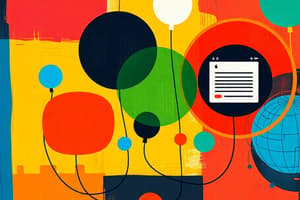Podcast
Questions and Answers
What is the primary role of the sender in the communication process?
What is the primary role of the sender in the communication process?
- To interpret the message
- To decide on and conceptualize the message (correct)
- To provide feedback on the message
- To convey the message through a channel
Which of the following best describes traditional media?
Which of the following best describes traditional media?
- Media that existed before the internet and mobile technology (correct)
- Media that focuses solely on TV and radio broadcasts
- Media that utilizes social media platforms
- Media that is produced using digital technology
In the evolution of media, which period is characterized by the absence of written or recorded history?
In the evolution of media, which period is characterized by the absence of written or recorded history?
- Industrial Stage
- Prehistoric Period (correct)
- Renaissance Era
- Digital Age
What is the function of feedback in the communication process?
What is the function of feedback in the communication process?
During which stage did the proliferation of printed materials occur, facilitated by inventions like the steam press?
During which stage did the proliferation of printed materials occur, facilitated by inventions like the steam press?
Which of the following is a characteristic of media literacy?
Which of the following is a characteristic of media literacy?
Which mode of communication is considered a channel in the communication process?
Which mode of communication is considered a channel in the communication process?
What was one of the earliest forms of traditional media?
What was one of the earliest forms of traditional media?
Which characteristic of a media and information literate person emphasizes accuracy in communication?
Which characteristic of a media and information literate person emphasizes accuracy in communication?
What signifies the transition from traditional media to electronic media in communication?
What signifies the transition from traditional media to electronic media in communication?
In the context of media literacy, which characteristic involves recognizing diverse perspectives?
In the context of media literacy, which characteristic involves recognizing diverse perspectives?
What is a key characteristic that reflects professionalism in media literacy?
What is a key characteristic that reflects professionalism in media literacy?
What era is marked by the emergence of multifunctional digital technology?
What era is marked by the emergence of multifunctional digital technology?
Which media characteristic drives individuals to engage actively in sourcing information?
Which media characteristic drives individuals to engage actively in sourcing information?
What advancement during the Electronic Stage significantly improved long-distance communication?
What advancement during the Electronic Stage significantly improved long-distance communication?
Which of the following is NOT a characteristic of a media and information literate person?
Which of the following is NOT a characteristic of a media and information literate person?
What type of media involves ink and paper in a printing process?
What type of media involves ink and paper in a printing process?
Which type of media allows for interactive, two-way communication?
Which type of media allows for interactive, two-way communication?
Which of the following is NOT a common type of cybercrime?
Which of the following is NOT a common type of cybercrime?
What does misuse of devices refer to in the context of cybercrimes?
What does misuse of devices refer to in the context of cybercrimes?
Which of the following best describes traditional media versus electronic media?
Which of the following best describes traditional media versus electronic media?
Which of the following is an example of primary information source?
Which of the following is an example of primary information source?
In media literacy, responsible media use includes which of the following?
In media literacy, responsible media use includes which of the following?
What is an essential characteristic of broadcast media?
What is an essential characteristic of broadcast media?
Flashcards are hidden until you start studying
Study Notes
Introduction to Media and Information Literacy
- Communication involves five elements: sender, medium, channel, receiver, and feedback.
- The sender creates the message, chooses the medium (e.g. letter, email), and uses a channel (e.g. post office, internet) to transmit it.
- The receiver interprets the message and provides feedback to determine understanding.
Media, Information, Technology Literacy, and the Responsible Use of Media and Information
- A media and information literate person possesses qualities like truthfulness, fairness, responsibility, empathy, and hard work.
- They prioritize accurate information and conduct themselves professionally.
The Evolution of Traditional to New Media
- Traditional media predates the internet and mobile technology.
- Prehistoric Period: Communicated through cave art (petroglyphs and pictographs), music and dance.
- Industrial Stage: Marked by inventions like the steam press and telegraph.
- Electronic Stage: Emphasis on electricity-powered media and long-distance communication.
- New or Information Stage: Characterized by digital technology and multifunctional devices.
Different Types of Media
- Print Media: Uses printing processes involving ink and paper.
- Broadcast Media: Relies on airwaves for transmitting audio and video content (radio and television).
- Film/Cinema: Depicts motion pictures or movies.
- Video Games: Interactive experiences that involve manipulating computer-generated images for entertainment purposes.
- New Media: Digital content distributed across various platforms, often incorporating interactive elements and two-way communication.
Media and Information Sources
- Primary Sources: Offer original, uninterpreted, first-hand evidence of information.
Types of Codes in Media
- Technical Codes: Include elements like camera angles, lighting, editing, and sound techniques.
- Symbolic Codes: Represent deeper meanings and connotations, encompassing things like color, setting, and acting.
- Written Codes: Employ language style and textual layout for communication, such as headlines, captions, and speech bubbles.
Legal, Ethical, and Societal Issues in Media and Information
- Cybercrimes: Offenses related to computer systems and digital technology.
- Illegal Access: Unauthorized access to computer systems or applications.
- Misuse of Devices: Unauthorized usage or distribution of devices or software designed for illegal activities.
- Computer-Related Fraud: Unauthorized manipulation of computer data or interference with system functionality.
- Computer-Related Identity Theft: Unauthorized use, possession, or alteration of identifying information.
Studying That Suits You
Use AI to generate personalized quizzes and flashcards to suit your learning preferences.




